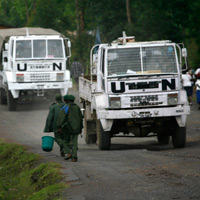

Here in North Kivu province, anxiety about the return of Congolese refugees from Rwanda has long been an especially contentious issue. Most of the refugees are Tutsis who fled North Kivu province during violent clashes in 1995 and 1996. However, violent disputes about the status of Congolese populations of Rwandan descent, especially Tutsis, predate both Congo’s cataclysmic war and the 1994 Rwandan genocide, in which a Hutu led Rwandan government killed 800,000 Tutsis and moderate Hutus. With the United Nations confirming that approximately 12,000 Tutsi have recently settled in transit camps in the Masisi and Rutshuru territories of North Kivu, this explosive issue has moved to the front burner and requires urgent attention to help prevent even further destabilization in this embattled region.
This recent population influx is particularly worrisome because it appears to be happening outside a formal agreement between the Rwandan and Congolese governments and the U.N. High Commissioner for Refugees, or UNHCR. Because people are crossing the border at night and avoiding official frontier posts, new population movements have not been captured by formal tracking systems. This does not mean, however, that the returns are not organized—there appears to be a system where buses are picking people up at the border and transporting them to the camps.
There are many unanswered questions about just who exactly these new arrivals are. UNHCR is stating that none of the approximately 52,000 officially registered Congolese refugees living in Rwanda have left (though UNHCR has allegedly not counted the population in the camps for more than two years). This suggests that the new arrivals are either unregistered refugees who were living with families while in Rwanda, or, potentially, that they are not refugees at all but rather Rwandan nationals with no prior residency in Congo.
With so little confirmed about the precise nature of these population movements, rumors are running wild here in Goma. I recently visited the town of Kisuma, in Masisi territory, in an effort to learn more about these unsettling developments. A source there told me that, on average, some 350 Tutsi families had settled in the area since April 2009. Moreover, the area is controlled by elements of the CNDP, the former rebel movement that had been commanded by Laurent Nkunda. Following Nkunda’s removal and the recent détente between Rwanda and Congo, CNDP established a parallel administration in the territory and is now reportedly facilitating the new population movements. CNDP leadership has tried to reassure local residents—the majority of whom are Hutus—that the new arrivals would stay only until they were able to return to their lands of origin, which were said to be in areas currently under FDLR control.
Rumors like this can be explosive. Concerns on the part of Hunde and Nande populations in the area, who fear that an influx of refugees and cattle will increase the competition for scarce land in Rutshuru and Masisi, in turn reinforce long-standing local fears of a Rwandan “colonization” of the Kivus. An already tense situation is posed to get much worse. A proactive effort to restore transparency and formality to the refugee return process is necessary to mitigate these rising tensions. UNHCR must urgently put in place a process to identify refugees and work with local authorities to manage potential land disputes that will arise. Authorities on all sides, both within Congo and across the border in Rwanda, will need to recognize that renewed outbreaks of land and intercommunal violence would intensify local conflict. If both sides are indeed interested in lasting peace in the Kivus, they would be wise to work together to find a solution.

